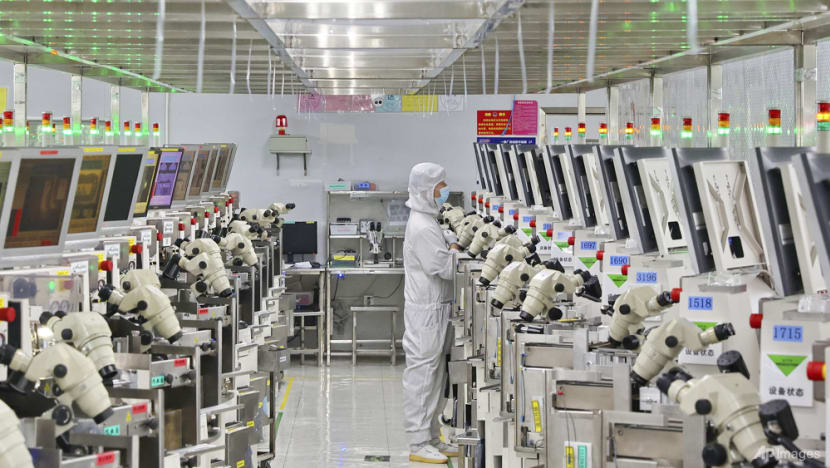Commentary: Will Trump tariffs push China to change economic tack?
Beijing is unlikely to change its underlying economic strategy even with a trade war brewing, says Natixis economist Gary Ng.

People shop at a commercial district in Beijing on Monday Jan. 27, 2025. (AP Photo/Aaron Favila)

This audio is generated by an AI tool.
HONG KONG: China cannot export its way out of its current economic woes. That has been the view since well before Donald Trump returned as United States president and started wielding tariffs more assertively.
But will the economic pressure he now creates force China to change its current policy stance and bring out a bigger proverbial “bazooka” to fix its economy? All eyes will be on the annual Two Sessions, which kicks off in Beijing on Tuesday (Mar 4).
China is perhaps the most prepared country to assess potential scenarios and reactions for Trump 2.0. And its reactions to the 10 per cent tariff hike on Chinese goods have been rather muted in retaliation and stimulus.
Mr Trump’s impending removal of the de minimis trade exemption – which allows small-value imports to enter the US duty-free – will hurt China's booming e-commerce sectors as the US is the biggest market, with a quarter of such exports in 2024. The US has pressured Mexico to impose tariffs on China's imports and has directed the Committee on Foreign Investment in the United States to restrict Chinese investment in strategic sectors.
To mitigate the losses from the US, China will be tempted to focus on exporting more to alternative markets, which is not a new story.
Over the past few years, China has strengthened its production capacity. Price disparities between China and the rest of the world have also widened since the pandemic, making consumer and producer goods prices highly competitive.
Some countries may see China's competition in their local markets and globally, leading to more trade restrictions. But even those they might have wanted to absorb more Chinese goods will find it harder to do, now that America is planning to impose reciprocal tariffs.
There is a clear trend that the US will switch its focus from “made-in-China” to “made-by-China” products which can affect countries relying on Chinese investment, such as Mexico and Vietnam. It will cost more to export to the US and more to increase US imports given Mr Trump’s obsession with closing the bilateral trade deficit.
EFFECTS OF CHINESE STIMULUS WON’T BE FELT BY ASIA
For many Asian nations, contending with a more assertive US while grappling with China's new reality of slower economic growth has proven challenging.
China will likely moderately step up fiscal and monetary policy, but it does not necessarily benefit other countries as much as during the global financial crisis.
The massive stimulus package at that time was 4 trillion yuan, equivalent to 11 per cent of gross domestic product in 2008. It was a big boost to China’s domestic demand mainly through credit expansion and infrastructure investment but with a cost of higher government debt. Other countries benefited as China imported more goods and commodities, cushioning the global shock in demand.
Things are different this time for two reasons.
First, the Chinese government is more concerned about debt than before and has set the tone to accept a slowly decelerating economic growth rate.
Unlike the past era, China now focuses on “high-quality development” with a more ambiguous growth target at “around 5 per cent”. The People’s Daily, flagship newspaper of China’s Communist Party, published an article in December 2024 stating China does not need to commit to a specific growth rate. There is also stronger emphasis on risks with local government debt restructuring and bank recapitalisation but less so on credit expansion.
The policy focus on long-term “high-quality development” will limit support to a piecemeal approach – proportional to the pressure from Mr Trump, nothing more and nothing less. A sudden rebound in China's economic growth is not likely, especially with problems arising from the ageing population and its beleaguered real estate sector.

Second, within a limited pool of stimulus, China will carefully allocate the benefits to domestic firms. Even if more substantial policy support exists, it will accelerate domestic substitution for consumers (replacing foreign imports with local production) and industrial upgrades for manufacturers.
The trends may still lift demand for certain products from other countries, such as commodities that China needs to make goods. However, the competition will be tougher for intermediate and final goods in a crowded space.
DONALD TRUMP WILL ACCELERATE CHINA’S GOAL OF SELF-RELIANCE
China will not be able to rely on external drivers and need to seek ways to boost domestic demand. The game changer is whether China provides a new and better social contract to replace the old model.
Since the reform and opening up policy in 1979, China has prioritised economic growth for prosperity. The rebalancing of policy objectives in recent years implies China is undergoing a transition period with uncertainties, leading to weaker consumer and business confidence.
Even if there have been further relaxations in regulations recently, such changes have yet to reignite consumption. The impact of recent consumer subsidies for electronic devices and home appliances is likely short-lived.
Whether the growth in disposable income, wealth effect and corporate profits can reaccelerate will be the fuel for reigniting positive sentiment. However, some policies may not bode well for a recovery in consumption: As part of the “common prosperity” campaign to redistribute wealth, wages for some government employees and in the financial sector have been reduced.
Structural changes will be required to reduce policy risks and create a competitively neutral environment for private and foreign firms with a more market-oriented approach.
China will not change its policy stance too much – it is simply not looking for a quick fix and will bite the bullet for its long-term vision. Donald Trump’s policies will only accelerate China's pre-existing goals of achieving self-reliance and building close relations with countries other than the US.
Gary Ng is senior economist at Natixis and research fellow at Central European Institute of Asian Studies (CEIAS).



















